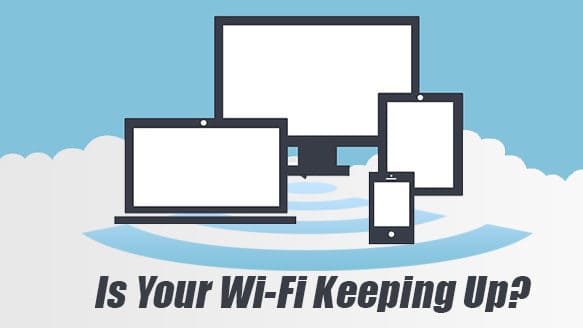15 years after Wi-Fi first made its way into homes with those mysterious rabbit-eared boxes, it’s evolved into something that we can’t do without and often take for granted. Think about how many wireless devices your home has – the average home has at least 10 devices connected wirelessly to the internet, many have more.
While older devices are typically happy with a slice of slow internet, your newer devices like Smart TVs and media streaming devices simply can’t function without fast internet. Add in a game console, tablet, a few smartphones and a laptop or two, and your Wi-Fi is suddenly stretched beyond full capacity and struggling to keep up. Yet, most people don’t know how fast their Wi-Fi is, or if it’s working right– they only know how many bars they’ve got. Unfortunately, counting bars is usually meaningless.
Here’s why relying on your Wi-Fi bar count might be ruining your internet experience:
Bars measure the wrong thing
While it’s great to know you’ve got a ‘strong’ signal, it would be even better if you could have a ‘fast and available’ signal. The internet could actually be down and you’d still have full bars because it’s really only measuring how close to the Wi-Fi router you are. That proximity measure doesn’t take into account how many devices are fighting for the same bandwidth or whether there’s any left for you. We can ensure your Wi-Fi isn’t just available, it’s up to the task.
Wi-Fi goes sideways
While next-door’s Wi-Fi can reach the back of their property, it can also go a similar distance sideways into your house. This extra ‘noise’ can disrupt and slow down your own Wi-Fi. This usually isn’t a big problem in New Zealand with houses further apart from each other, but if you see a lot of WiFi networks that you know nothing about, you’ve got a problem! In dense areas, your Wi-Fi is basically getting lost in a swirling field of signals, all using the same channel and frequency. It’s a digital crowd which can seriously slow your speeds. We can fix this by changing your Wi-Fi channel to one with less cross-talk.
Everyone uses the default settings
Most home Wi-Fi uses a 2.4ghz frequency by default. While it makes a plug & play router easy to set up, it does mean you’re not getting the speeds you could be. Switching to the 5ghz frequency means your Wi-Fi is separated from the neighbourhood cross-talk. 5ghz is also considerably faster, which is a bonus. Not to mention, it won’t interfere with your microwave or cordless phones! We can help you upgrade to a 5Ghz-capable router or switch your existing frequency.
Wireless coverage doesn’t reach all rooms
This is a common issue in New Zealand, especially if you have a large house with many bedrooms, or the house has two or more stories, attic, or a basement. Most of the time, when you sign up for the Internet service, your provider will try to cut the costs as much as possible and give you a router that, perhaps, might be ok for a small apartment, but won’t be sufficient to cover your house. Spark and Vodafone are the ones that come to mind – their routers are among the cheapest and provide a subpar coverage. 2 degrees is better – their router is good enough for a typical 3bd home.
You use WiFi extenders
Some people try to combat the problem by using WiFi extenders. They are cheap and relatively easy to setup. However, if the extender communicates with the router on the same frequency as all other devices, it will slow down everyone on that network. When devices are close to each other and on the same channel, they create interference which causes each device to have to re-transmit (a bit like two people talking at the same time resulting in a lot of “pardon? can you repeat that please as I could not hear because someone else was talking at the same time”). When you have to re-transmit, you slow everything down, waste valuable bandwidth and generally make everything seem worse.
We can replace your home WiFi router with a much better one!







